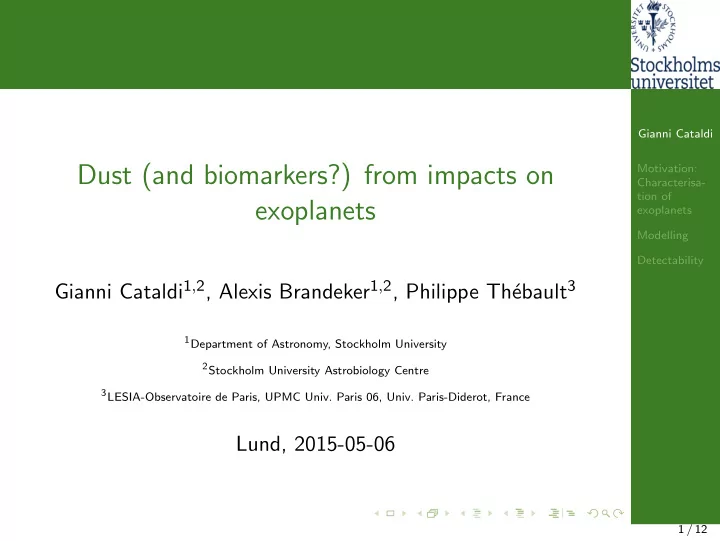

Gianni Cataldi Dust (and biomarkers?) from impacts on Motivation: Characterisa- tion of exoplanets exoplanets Modelling Detectability Gianni Cataldi 1 , 2 , Alexis Brandeker 1 , 2 , Philippe Th´ ebault 3 1 Department of Astronomy, Stockholm University 2 Stockholm University Astrobiology Centre 3 LESIA-Observatoire de Paris, UPMC Univ. Paris 06, Univ. Paris-Diderot, France Lund, 2015-05-06 1 / 12
Outline Gianni Cataldi Motivation: Characterisa- tion of 1 Motivation: Characterisation of exoplanets exoplanets Modelling Detectability 2 Modelling the impact event and collisional evolution 3 Detectability 2 / 12
Characterisation of Earth-sized exoplanets • Earth-like planets around Sun-like stars appear to be Gianni Cataldi relatively common Motivation: • ultimate goal: find a second genesis of life Characterisa- tion of • large variety of planetary bodies in the solar system exoplanets (atmospheres, surface properties, composition,. . . ) Modelling Detectability • characterisation of detected exoplanets warranted Image credit: NASA Ames/SETI Institute/JPL-Caltech 3 / 12
Techniques to characterise exoplanets • radial velocity and transits (bulk properties) Gianni Cataldi • spectroscopy (atmosphere, surface) Motivation: Characterisa- • . . . impact event? tion of exoplanets Modelling Detectability b 3,650 Best- f t model: 190 × solar metallicity Pure water model: 10,000 × solar metallicity 3,600 Solar cloud-free model with low C/O Solar model with clouds at 80 mbar 3,550 Solar cloud-free model ( R p / R s ) 2 (p.p.m.) 3,500 3,450 3,400 3,350 3,300 1.2 1.3 1.4 1.5 1.6 Wavelength ( μ m) Fraine et al. (2014) 4 / 12 ʘ
Idea: dust from impact on exoplanet • impact accelerates surface material (potentially including Gianni Cataldi biomarkers) to escape velocity Motivation: • escaping fragments form circumstellar belt Characterisa- tion of • mutual collisions produce dust (debris disk-type evolution), exoplanets resulting in much larger surface area Modelling • is detection of planetary dust possible? Biomarkers? Detectability Image credit: David Hardy 5 / 12
Modelling of the impact event Gianni Cataldi Motivation: Characterisa- tion of 1 Calculate amount of escaping mass for given impact exoplanets scenario Modelling • total escaping mass Detectability • mass escaping without substantial shock damage 2 assess collisional evolution using simplified analytical model (debris disk) 3 estimate fractional luminosity as a function of time 6 / 12
1. How much material is escaping? For a 20 km diameter impactor: Gianni Cataldi Motivation: Characterisa- parameter asteroid tion of Earth Mars Moon exoplanets 6 . 7 × 10 15 2 . 5 × 10 16 8 . 4 × 10 16 M ( > v esc ) kg Modelling < 46 GPa % 9.9 17.2 20.3 Detectability parameter comet Earth Mars Moon 5 . 8 × 10 15 2 . 4 × 10 16 8 . 0 × 10 16 M ( > v esc ) kg < 46 GPa % 11.2 11.8 12.6 reference values: Earth continental crust 1 . 5 × 10 22 kg; asteroid belt 3 × 10 21 kg; zodiacal dust 2 × 10 16 kg 7 / 12
2. Collisional evolution • relevant processes: Gianni Cataldi • atmospheric braking: lower size cutoff • collisions (production of smaller fragments) Motivation: Characterisa- • radiation pressure (removal process) tion of • Poynting-Robertson (PR) drag (removal process) exoplanets Modelling • assess collisional evolution under various simplifying Detectability assumptions (size distribution, collisions / PR drag,. . . ) Image credit: Kouji Kanba / ISAS / JAXA 8 / 12
3. Fractional luminosity (as a function of time) f = L dust / L ∗ Gianni Cataldi Motivation: Characterisa- tion of exoplanets Modelling Detectability 9 / 12
fractional luminosities parameter asteroid Gianni Cataldi Earth Mars Moon Motivation: Myr 1.8 0.7 0.3 t min , ini Characterisa- Myr 3.4 1.7 1.0 tion of t max exoplanets 5 . 8 × 10 − 9 1 . 7 × 10 − 8 4 . 7 × 10 − 8 - f max , bl Modelling 2 . 4 × 10 − 10 1 . 3 × 10 − 9 5 . 5 × 10 − 9 - f max , PR Detectability parameter comet Earth Mars Moon t min , ini Myr 1.3 0.5 0.2 t max Myr 2.1 0.9 0.5 7 . 8 × 10 − 9 2 . 6 × 10 − 8 7 . 2 × 10 − 8 f max , bl - 3 . 9 × 10 − 10 2 . 5 × 10 − 9 1 . 1 × 10 − 8 f max , PR - reference values: HR 4796A 5 × 10 − 3 ; zodiacal dust 10 − 8 − 10 − 7 ; Kuiper belt dust ∼ 10 − 7 10 / 12
. . . so, can we detect the fragments? • difficult with current instrumentation. . . Gianni Cataldi • . . . but in the reach of future instruments (e.g. Darwin, Motivation: Characterisa- ELT,. . . ) tion of exoplanets Modelling Detectability Roberge et al. 2012 11 / 12
Summary Gianni Cataldi Motivation: • for a given impact, we computed the escaping mass, its Characterisa- tion of collisional evolution and the fractional luminosity exoplanets • f dust ≈ f zodi Modelling Detectability • dust from impacts on exoplanets is difficult to detect with current instrumentation, but future instruments will be able to detect such dust • background source: exozodiacal dust • next step: study dust composition (biomarkers) with spectroscopy? 12 / 12
fragment size distribution Gianni Cataldi 1 / 3
timescale for (catastrophic) collisions Gianni Cataldi 2 / 3
Impact rate Gianni Cataldi Chapman 2004 3 / 3
Recommend
More recommend